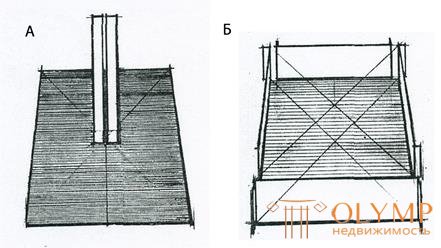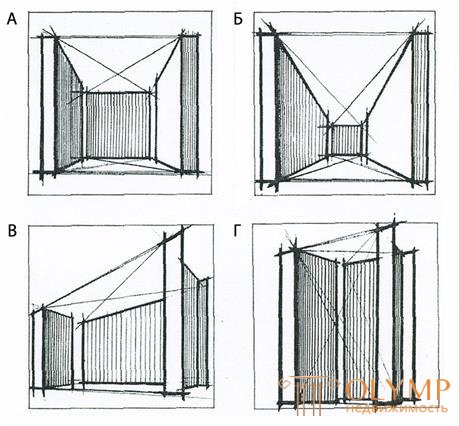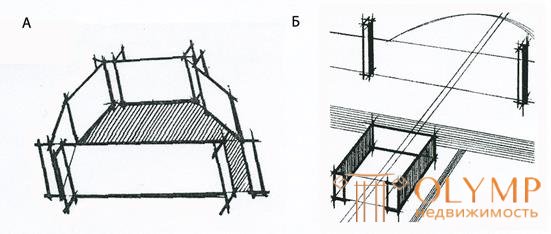
The composition of the architectural space on the basis of their organization can be divided into two types:
1) spaces organized around one or a group of architectural elements;
2) spaces bounded by elements along the perimeter.
The first type of composition of the architectural space is called unlimited space, since this type of organized space has no clear material boundaries, the second type is limited space, since this architectural space has certain, materially expressed limitations (Fig. 59).
The organization of unlimited architectural space involves: the main (main) architectural volume or group of volumes around which the space is organized, and the surface of the base on which the spatial composition is located.

Figure 59: A - scheme, unlimited space; B - scheme, limited space
The position of the main element in an unlimited space is determined with respect to the axes of coordinates, relative to which it can occupy the main or intermediate in importance position, i.e., be in a horizontal, vertical or inclined position.
For the base surface in unlimited space, its shape and position in space is characteristic.
The most common form of the base surface is conditionally flat (horizontal) and conditionally convex (complex).
The sense of organization of unlimited space increases towards the main architectural volume. Therefore, the dynamics and intensity of the compositional sphere depend primarily on the activity of the solution of the architectural element and its interaction with the surface of the base.
The main compositional element carries simultaneously the functions of the center and the dominant spatial composition, as it is, in fact, the only material basis for this type of organization of the architectural form. The relevance of the compositional decision of the main architectural element depends on its shape, size, massiveness, position in space, plastic detection. Naturally, the interaction of the main architectural element with the surrounding space, the expressiveness of the entire compositional construction largely depends on all these factors (for example, the Eiffel Tower in Paris. The vertical development of this dominant creates dynamics not only in itself, but also affects the perception surrounding space).
The surface of the base in unlimited space is the most important element of this type of composition. Depending on the nature of the surface and the interaction with the main element, it can determine the nature of the spatial composition. With a flat horizontal surface of the base, the most common solutions of the basic elements lie within the limits concluded between the solution, when the element is developed vertically and opposed to the horizontal surface of the base, and another case is when the element approaches the uniform-sized form.
Thus, the nature of an unlimited architectural space depends on the characteristics of the main compositional element, the nature of the base surface and the interaction of these elements of the composition.
In the composition of a limited architectural space are involved:
1) the surface of the base;
2) elements bounding the space around the perimeter; 3) the surface of the ceiling (in the interiors).
The architectural spaces of this type are classified among themselves according to the signs (size, relation of coordinates, plan shape, degree of closure). These signs, on the one hand, are the most significant and common for the spaces of this type, on the other hand, they allow to divide individual compositional decisions into groups depending on the parameters of these signs.
The ratio of the spaces among themselves in size does not require special explanations (a large space - a smaller space). The ratio of coordinates characterizes the general proportions of space in three dimensions. The horizontal section (plan) gives a basic idea of the shape of the space. The degree of closeness characterizes the connection of the limited space with the environment.
Coordinate ratio
Spatial composition in architecture, as a rule, assumes that the spectator perceives it in motion. From different points of view, the composition of space is perceived differently. Thus, from one point the viewer can perceive the entire depth of space, on the other - only the plane of the element bounding this space. To classify a limited space according to the ratio of coordinates, it is necessary to evaluate it from the most characteristic point of perception, whence the viewer most clearly perceives the overall design of the composition and the general proportions of space.
By proportions, the limited spaces are divided into the following main groups: UNIFORM, DEPTH, FRONTAL, VERTICAL (fig. 60):
→ Equivalent bounded spaces are spaces that approach cubic, that is, equal in three dimensions.
→ The deep space is characterized by the fact that it has the main development in depth with the equal height of the limiting elements and the width of the base. Its perception is directed along the deep coordinate.
→ Frontal space has a major development on the front. The deep and vertical coordinates in it have a subordinate value and can be close in magnitude or equal to each other, but the deep coordinate should not be too small, since in this case the space can disappear. The perception of the viewer in the frontal space will be directed perpendicular to the developed coordinate or will pass along the front.
→ In vertical spaces, the horizontal coordinates are in contrast to the vertical. Spaces of this type can be perceived by the viewer not only from the base surface, but also, as often happens in modern architecture, when moving from the bottom up and from the top down.

Figure 60: A - geometrical scheme of non-oriented space;
B - geometrical scheme of the deep space; B - diagram of the frontal space; G - geometric scheme of vertical space.
Plan form
The location in terms of elements limiting space is one of the important factors characterizing spatial organization. The plan gives the main characteristic of the form of space. The forms of architectural space plans are divided into two groups: simple geometric (square, trapezium triangle, circle, etc.) and complex geometric.
Degree of isolation
According to the degree of closure, limited spaces are divided into exterior and interior; these spaces are distinguished by the presence of overlap in the interiors and its absence in the exteriors. The degree of closure of exterior spaces is determined by the size, massiveness of the elements that limit the space, the intervals between them. The more massive the elements, the closer they are to each other, the more they close the space, separating it from neighboring spaces and the environment.

Figure 61: A - closed space; B - open space
The degree of closure of interior spaces depends on the ratio of the mass of elements, its limiting, and the size of the openings.
15.4 Construction and identification of limited architectural
Composite axes
In the composition of limited space can be used the principle of symmetry and asymmetry.
The basis of the symmetric construction of a limited architectural space is the axis of symmetry. It is the main direction of development of the composition, the basis, organizing the sequence of movement and perception of the viewer.
The basis of the asymmetric construction of a composition of a limited architectural space is the axis of equilibrium. In a composition of this type, it is not fixed rigidly, since its position is determined by the position of the observer and the placement of the visible elements and their surrounding space. The outline of the axes in the spatial composition can also be different (from rectilinear to curvilinear).
In architecture, spatial constructions with several compositional axes are quite common. In this case, the direction of the axes and their value in the composition may be different (parallel, perpendicular, angled, etc.).
Composite axes can go in different directions, starting from one point or intersecting with it.
Thus, the compositional axes, their location, the character of their outlines, etc., form the basis (backbone) of the architectural space. The place of intersection of the axes is the most important point of the spatial composition, since here several areas of compositional development are concentrated. Composite axes and the place of their intersection largely determine the location of the composite center and the dominant.
Что бы оставить комментарий войдите
Комментарии (0)